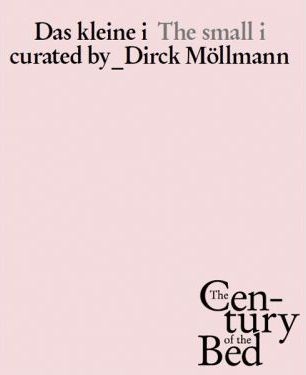The small i
03 Oct - 08 Nov 2014
THE SMALL I
James Cabot, Lana Cmajcanin, Saskia Noor van Imhoff, Paul Etienne Lincoln
3 October - 8 November 2014
curated by Dirck Möllmann
The bed is a counter-space for work. Inactive. We rest, and our bodies work without us. Warmth, digestion, relaxation. We dream. The subconscious works on us. We make love. Everything else happens of its own accord. We need the bed; it allows us to become inoperative. The bed demands no decision between active and passive, between yes and no; it does not compel us to make sense. It makes room for other states. We sleep, we die in bed. The bed is more than a counter-space. By bringing together work and inactivity, it suspends the daily conflict centered around meaning and the ceaseless quest for meaning—the bed is like The Neutral1. It makes time stand still. A passionate place, a state of fervor, an intensity of exhaustion. With deep trust. In dreamless sleep. As a pair, or alone. Following sleep is an awakening. “I always sleep, I need time to wake up, to understand,” said André Gide on his deathbed. His awakening circumscribes an understanding delayed in time. Slow to understand. Wordless. Full of images. The show The small i could also be called The small n like The Neutral, or The small a like the object small a. The small i refers to the state of being inoperative, useless, inactive, and simultaneously receptive to other signals of communication. More like the static in the erratic yearning for a potentia passiva2. A state of limbo, similar to art, in a delicacy of feeling that serves no end (Barthes).
The artworks collected here originate from two different generations of artists, and also from different periods. None of them treat the bed as a motif. Discernible in each work is this special state of being inoperative and open to the senses at the same time. Be it through absence, as in the case of this delicate vacuum caught in a state of dissolution in the work of Paul Etienne Lincoln (on view are drawings, documents, and excluded editions of the original work); through the presence of a constrictive reading experience in Lana Čmajčanin’s works; in the fascinating form-related material of collective temporal forms by James Cabot; or in the elegant, abeyant state of seeing and understanding in the installations of Saskia Noor van Imhoff. Embodied in each of these works is the impossible possibility of art. And that is what ultimately matters.
1 Roland Barthes, The Neutral [1977–78] (New York, 2005).
2 Kathrin Busch, “Passivität”: Kleiner Stimmungsatlas in Einzelbänden, vol. 6: P: Passivität, ed. Jan-Frederik Bandel and Nora Sdun (Hamburg, 2013).
Dirck Möllmann (*1963) is curator at the Institute of Art in Public Space Styria, Universalmuseum Joanneum, Graz.
James Cabot, Lana Cmajcanin, Saskia Noor van Imhoff, Paul Etienne Lincoln
3 October - 8 November 2014
curated by Dirck Möllmann
The bed is a counter-space for work. Inactive. We rest, and our bodies work without us. Warmth, digestion, relaxation. We dream. The subconscious works on us. We make love. Everything else happens of its own accord. We need the bed; it allows us to become inoperative. The bed demands no decision between active and passive, between yes and no; it does not compel us to make sense. It makes room for other states. We sleep, we die in bed. The bed is more than a counter-space. By bringing together work and inactivity, it suspends the daily conflict centered around meaning and the ceaseless quest for meaning—the bed is like The Neutral1. It makes time stand still. A passionate place, a state of fervor, an intensity of exhaustion. With deep trust. In dreamless sleep. As a pair, or alone. Following sleep is an awakening. “I always sleep, I need time to wake up, to understand,” said André Gide on his deathbed. His awakening circumscribes an understanding delayed in time. Slow to understand. Wordless. Full of images. The show The small i could also be called The small n like The Neutral, or The small a like the object small a. The small i refers to the state of being inoperative, useless, inactive, and simultaneously receptive to other signals of communication. More like the static in the erratic yearning for a potentia passiva2. A state of limbo, similar to art, in a delicacy of feeling that serves no end (Barthes).
The artworks collected here originate from two different generations of artists, and also from different periods. None of them treat the bed as a motif. Discernible in each work is this special state of being inoperative and open to the senses at the same time. Be it through absence, as in the case of this delicate vacuum caught in a state of dissolution in the work of Paul Etienne Lincoln (on view are drawings, documents, and excluded editions of the original work); through the presence of a constrictive reading experience in Lana Čmajčanin’s works; in the fascinating form-related material of collective temporal forms by James Cabot; or in the elegant, abeyant state of seeing and understanding in the installations of Saskia Noor van Imhoff. Embodied in each of these works is the impossible possibility of art. And that is what ultimately matters.
1 Roland Barthes, The Neutral [1977–78] (New York, 2005).
2 Kathrin Busch, “Passivität”: Kleiner Stimmungsatlas in Einzelbänden, vol. 6: P: Passivität, ed. Jan-Frederik Bandel and Nora Sdun (Hamburg, 2013).
Dirck Möllmann (*1963) is curator at the Institute of Art in Public Space Styria, Universalmuseum Joanneum, Graz.

